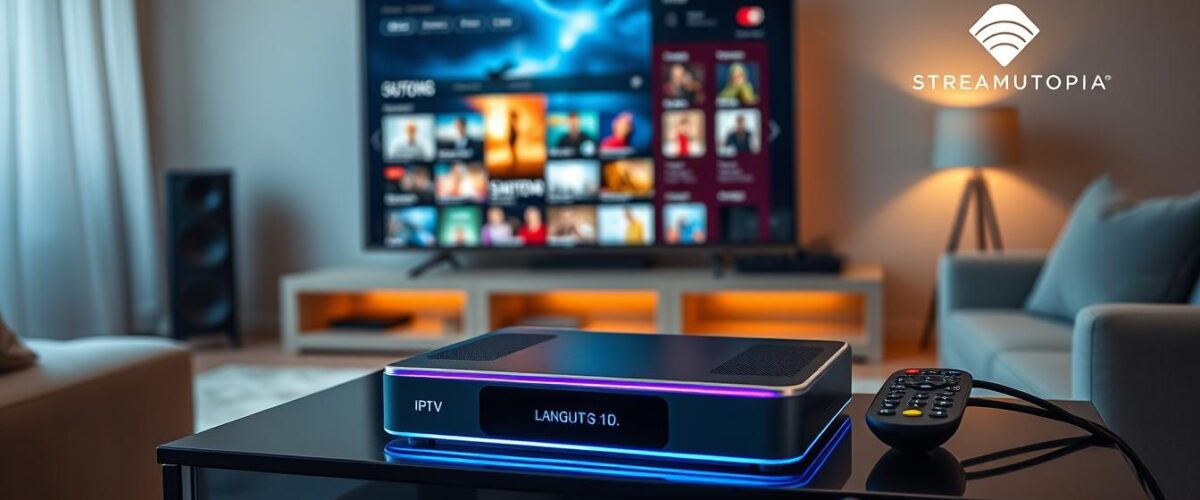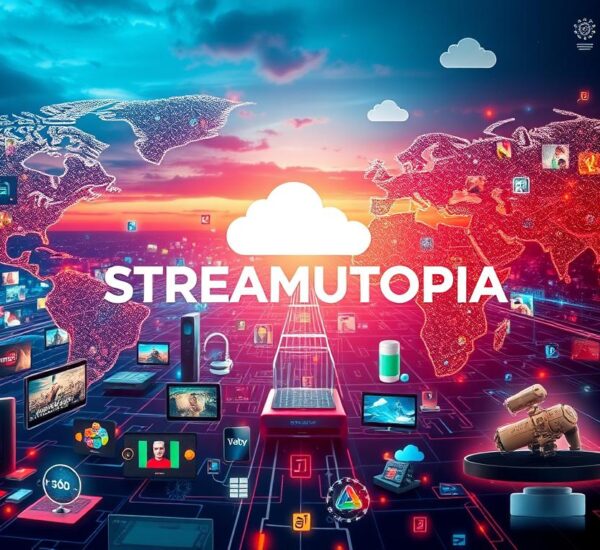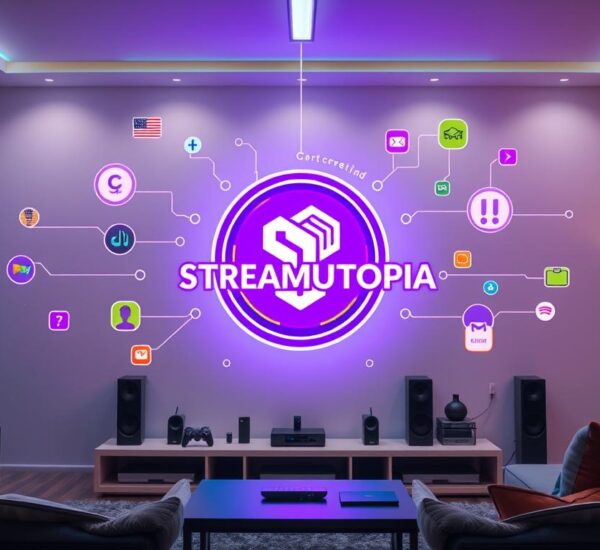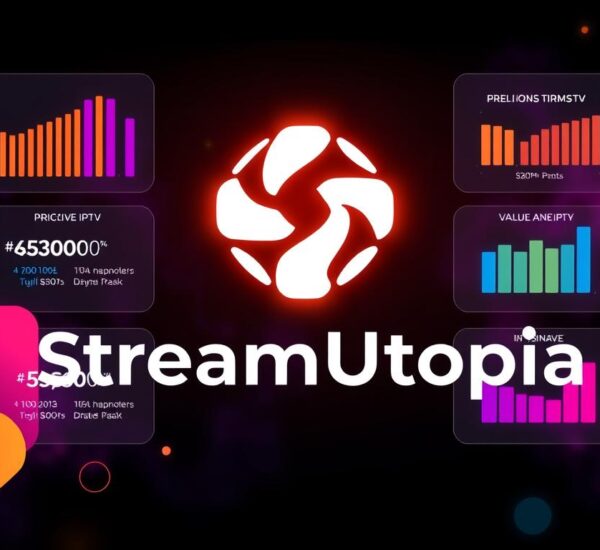Ever thought about how streaming could change with just one device? IPTV, or Internet Protocol Television, is a big leap from old-school TV to streaming over the internet. An IPTV box connects your internet to your TV, letting you watch lots of channels and shows anytime, anywhere.
This article will help you understand IPTV and how to set it up for the best viewing. We’ll cover everything from what IPTV is to picking the right box. You’ll learn how to make your entertainment better with IPTV.
IPTV is becoming popular because it lets you access content easily. It offers live channels and movies, making home entertainment more exciting.
Let’s explore IPTV’s benefits, challenges, and future. Whether you love sports or binge-watching, we’ll dive into IPTV services that could change your viewing forever.
Key Takeaways
- IPTV uses the internet to deliver TV services, including on-demand and live content.
- IPTV boxes convert internet signals into a format your TV can display.
- Viewers can access IPTV on various devices like smart TVs, computers, and smartphones.
- The IPTV market is projected to grow significantly in the coming years.
- IPTV services offer flexibility and convenience, allowing viewers to select what and when to watch.
What is IPTV?
IPTV stands for Internet Protocol Television. It’s a new way to watch TV over the internet. This method lets you watch live TV and on-demand shows. You can watch on devices like Smart TVs, smartphones, and tablets.
IPTV is different from old TV because it uses the internet to send shows. This means you can watch TV anytime, anywhere. You can also catch up on shows you missed.
IPTV services come in different prices, from $9.95 to $44 a month. This lets you pick what fits your budget. Streamutopia even offers a 24-hour free trial. You can watch on many devices, like Android and Apple TVs.
IPTV services have lots to offer. You get over 1,000 channels, sports, and a big Video-On-Demand library. They also have features like EPG and parental controls to make watching TV better.
| Feature | Description |
|---|---|
| Content Delivery | Streams through the internet, offering flexibility and variety. |
| Device Compatibility | Supports Android, iOS, Smart TVs, and streaming devices like Roku and Apple TV. |
| Subscription Cost | Ranges from $9.95 to $44 per month, with various plans available. |
| Trial Periods | Providers often offer trials lasting 10, 30 days, or a 24-hour free trial. |
| Channel Access | Includes access to over 1,000 channels, including sports and on-demand content. |
| Essential Features | Includes EPG and parental controls for enhanced viewing. |
IPTV changes how we watch TV. It offers personalized viewing experiences. With so many options, you can find what fits your lifestyle and preferences.
Understanding IP TV Box Compatibility
An IP TV Box is key for getting IPTV signals and making them work with TVs. It’s important to make sure your IP TV Box works well. Most connect via HDMI or AV cables, linking your box to your TV. Newer models also support Wi-Fi, making them better for smart TVs.
Choosing the right IP TV Box depends on its support for streaming services. Services like Apollo Group TV and Hulu offer lots of channels and movies. With over 120,000 channels from some providers, it’s crucial to know how your device works with these services.
Setting up your IP TV Box might face some challenges. Older devices might not support the latest IPTV standards. You might need to update or replace your device to avoid problems. IPTV uses packet-based systems, which can be affected by bandwidth and location. So, checking your device’s specs is important for a smooth viewing experience.

IPTV Setup Instructions
Setting up IPTV on an IP TV Box is easy. First, connect the IPTV box to your TV with HDMI or AV cables. A good connection is key for a smooth viewing experience.
Then, connect the box to your home internet. You can use a wired connection or Wi-Fi. Turn on the device and open the app from your IPTV service provider. Use your login details to access your content.
Before watching your favorite shows, check your internet speed. For standard quality, you need at least 10 Mbps. For UHD streaming, 25 Mbps or more is required. This ensures you don’t face buffering issues, making your streaming better.
Here’s a quick summary of the IPTV setup steps:
| Step | Description |
|---|---|
| 1 | Connect the IPTV box to your TV using HDMI/AV cables. |
| 2 | Connect the box to the internet (wired or Wi-Fi). |
| 3 | Power on the box and open your IPTV service provider’s app. |
| 4 | Log in using your subscription credentials. |
| 5 | Check your internet speed for optimal streaming quality. |
Follow these IPTV setup instructions to get your service running smoothly. Enjoy a wide range of content without any hassle. Happy streaming!
How Does IPTV Work?
IPTV relies on Internet Protocol to deliver content. It breaks down video signals into data packets sent over the internet. When you pick a program on your IP TV Box, it sends a request to IPTV servers. These servers then send the content through fiber-optic cables.
This method lets you watch what you want, when you want. It’s like browsing the internet, not channel surfing.
In the last 20 years, IPTV has changed the streaming world. It supports services like Apple, Amazon, and YouTube. You can start a subscription for as little as $19.99. This gives you access to thousands of channels, including international ones.
IPTV has many benefits:
- Managed Network Delivery: IPTV uses managed networks for stable content delivery. It supports multicast streaming for a great viewing experience.
- Live and On-Demand Options: You can watch live broadcasts and videos on demand. This meets your viewing preferences.
- Catch-Up TV: Time-shifted TV lets you watch shows you missed within a certain time.
- Sports Coverage: IPTV is great for sports fans. It offers a wide range of live sports events.

This new approach is becoming more popular. People use set-top boxes to turn internet signals into TV broadcasts. The demand for internet streaming is growing. This is leading to a hybrid IPTV model that combines linear broadcasting with on-demand content.
This change marks a big shift from traditional TV. IPTV offers a more efficient and personalized experience. It’s key in today’s fast-changing media world.
For more on IPTV’s benefits and features, check out this resource.
Choosing the Right IP TV Box
Choosing the right IP TV Box is key for a great IPTV experience. You need to think about your TV’s compatibility, streaming services, and setup ease. Popular models are known for their features and how happy users are.
| IP TV Box | Resolution | Key Features | Internal Storage |
|---|---|---|---|
| Formuler Z8 | 4K | Outstanding UI, ultra-high definition, HDR support | 16GB |
| MAG 324 | 1080p | Speedy performance, reliable internal antenna | N/A |
| BuzzTV XR4000 | 4K | Fast performance, backup and restore function | 16GB |
| Dreamlink T1/T2 | 4K | Affordable, rich app support, HDR | N/A |
| Formuler Z7+ | 1080p | Vivid picture quality, good UI | N/A |
| MAG 322 | 1080p | Solid specs, strong wireless connection | N/A |
Many users like a wired connection for better stability. This is especially true if your internet speed is over 18 Mbps. A wireless connection works well if your ping rate is low. Some brands, like Vodafone, might not be the best for IPTV. It’s smart to test different services during a trial before you commit.
Knowing how to sideload can make your viewing better. You can install apps not supported by the box. Clearing the cache and rebooting your router can fix common problems. Also, look for models that let you use one subscription on multiple TVs. This can save you money.
Everything You Need to Know About Using IPTV on an IP TV Box
Using IPTV on an IP TV Box opens a world of entertainment. You can watch movies and shows whenever you want. It’s important to know how to use your IPTV app well.
Users can find live channels, recorded shows, and video-on-demand easily. This makes watching TV a breeze.
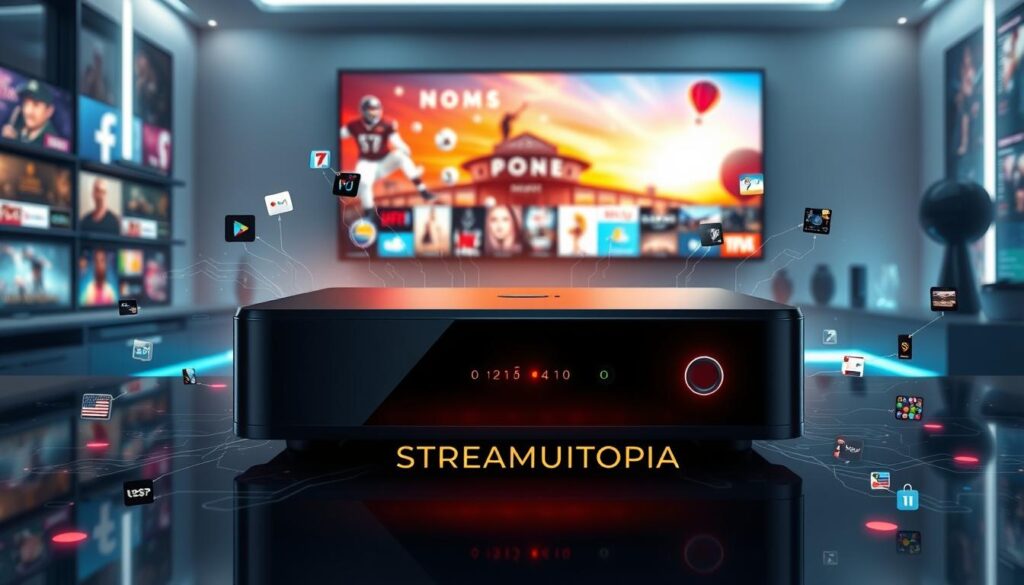
Keeping your IPTV box updated is key for a great experience. This stops problems and makes streaming better. You’ll get better picture and sound quality.
Using parental controls helps keep your family safe. It lets you choose what’s okay for everyone to watch.
Interactive features like live polls make watching TV more fun. When picking an IPTV service, think about the content, quality, and support. Reading reviews helps you make a good choice.
IPTV needs a fast internet connection and a router. You also need a set-top box or a smart TV. Following these tips will help you enjoy IPTV’s benefits without the high costs of cable or satellite TV.
Best IPTV Services Available
The world of IPTV services is growing fast. It offers many popular streaming options for different tastes. Hulu + Live TV, Sling TV, YouTube TV, and fuboTV are top choices. They have lots of channels and on-demand content. You can try them out with free or low-cost trials.
Knowing the differences between IPTV providers can make your viewing better. There are two main types: services with their own apps and those that need external players. Legal services in app stores are safer, but cheaper options might have risks.
Good IPTV services give you high-quality content, up to 1080p HD. You’ll need at least 25Mbps internet for the best streaming. Many people like Amazon FireStick for its flexibility and price.
When picking an IPTV service, think about the cost, live TV, connections, VPN, and support. Learning about Catch Up, Connections, and EPG can help you choose better.
IPTV Streaming Tips for Enhanced Viewing
To get the most out of IPTV, start with a strong internet connection. You’ll need a speed of at least 10 Mbps for standard quality. For 4K, you’ll need even more. Using a VPN, like ExpressVPN, can also protect your privacy and help you access content not available in your area.
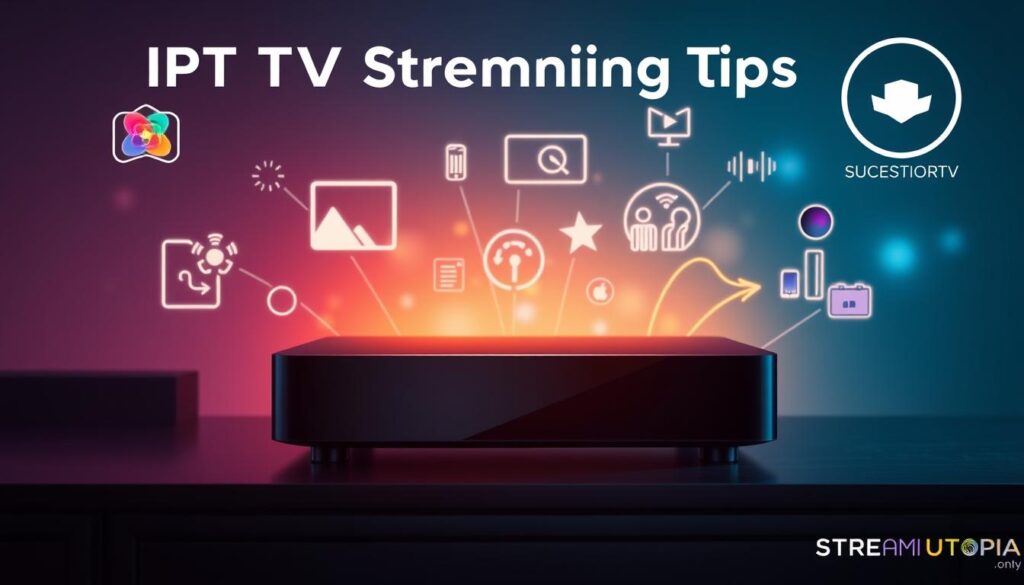
Check the video quality settings in your IPTV app. Adjusting these based on your internet speed can stop buffering and make streaming smoother. Also, keep your IPTV app updated for new features and better performance.
- Choose a service provider wisely by checking content offerings, pricing plans, and customer reviews.
- Consider bandwidth requirements, especially if you plan to stream HD or 4K content.
- Monitor buffering issues during peak times, particularly for popular events like sports.
Remember, the quality of streams can vary a lot between IPTV providers. Devices like the Nvidia Shield can improve picture quality, especially on big screens. Make sure to turn on hardware decoding in your IPTV app for the best picture.
It’s also important to know the legal side of IPTV. Knowing about copyright laws and geo-restrictions can avoid legal trouble. As technology gets better, we can expect even better streaming quality and compatibility with devices.
IPTV Channel Guide: What to Expect
IPTV services offer a wide range of channels for different interests. You can find local stations, international networks, sports, and movies. It’s important to know the IPTV channel guide to explore what’s available.
Knowing what channels you can expect helps choose the best service. The variety of channels greatly affects your viewing experience. IPTV services often include:
- Entertainment: With dramas, comedies, reality shows, and more.
- News: Keeping you updated with current events and analysis.
- Sports: Live coverage of major leagues and events.
- Movies: A wide selection of films across genres.
- Specialty Channels: For interests like cooking, travel, and more.
Each IPTV service has its own unique channel lineup. It’s key to research before subscribing. Check the service’s website for the latest IPTV channel guide. This guide helps you choose the right subscription for your needs and budget.
Troubleshooting IPTV Issues
Troubleshooting IPTV issues involves solving common problems. Buffering is a big issue, often due to slow internet. For smooth streaming, you need at least 7-10 Mbps download speed and 1-3 Mbps upload speed.
Wired connections should have at least 25 Mbps. Wi-Fi connections should aim for 150 Mbps, depending on your home setup.
For those with buffering issues, premium IPTV servers are a good choice. They cost between $15 to $25 and offer better quality. Cheaper options might cause slowdowns and buffering.
Doing a speed test can show any big lags. Some suggest using an Ethernet Over Power adapter for a direct connection. Adjusting the buffer size on receivers can also help.
Resetting routers is a good step if you’re facing audio or video problems. This should be done if it’s been a while.
If playback issues continue, VLC Player on a PC might help. Disabling family safe settings and restarting equipment can also solve problems. Using a VPN can help with ISP throttling.
Lastly, keep a list of customer support contacts handy. This can speed up finding solutions to ongoing issues.
IPTV Device Recommendations
Choosing the right devices for IPTV streaming is key. The Amazon Fire Stick is easy to use and works well with many IPTV services. The Roku platform offers a variety of channels in a simple interface. Apple TV is great for those who use Apple products and want easy integration. These are top picks for IPTV boxes today.
Android-based streaming boxes offer flexibility and customization, appealing to tech-savvy users. Desktop options like IPTV Smarters or Kodi are perfect for watching on bigger screens. These options make IPTV more enjoyable and tailored to your needs.
Here’s a table showing some of the best IPTV boxes available:
| Device | Compatibility | User Experience | Customization |
|---|---|---|---|
| Amazon Fire Stick | Excellent | Easy to use | Limited |
| Roku | Excellent | User-friendly | Limited |
| Apple TV | Excellent | Smooth integration | Moderate |
| Android Box | Good | Flexible | Highly customizable |
| IPTV Smarters | Good | Desktop experience | Limited |
| Kodi | Good | Versatile | Highly customizable |
These recommendations help users find the perfect device for their IPTV needs.
Benefits of Using IPTV Over Traditional TV
More and more people are switching from traditional TV to IPTV. The benefits of IPTV are clear, making it a popular choice for many.
IPTV offers flexibility that traditional TV can’t match. Users can watch their favorite shows whenever they want. With a growth rate of 30% to 35%, IPTV has attracted over one billion subscribers worldwide.

Cost-effectiveness is a big reason for IPTV’s popularity. Plans are often cheaper than traditional TV, letting users only pay for what they watch. This is a big difference from the high costs of cable TV, which includes extra fees.
The benefits of IPTV also include better viewing quality. IPTV offers HD and 4K content without the signal problems of cable. People enjoy watching high-quality streams on devices like Smart TVs, tablets, and smartphones.
Comparative Overview of IPTV and Traditional TV
| Feature | IPTV | Traditional TV |
|---|---|---|
| Subscription Cost | Generally lower, flexible plans | May include installation and rental fees |
| Content Quality | HD and 4K available | Primarily HD, limited 4K |
| Device Accessibility | Available on multiple devices | Limited to TV set |
| Global Access | International channels available | Limited to regional programming |
| Signal Interference | Less interference | Subject to signal issues |
IPTV is a great choice for those looking to mix up their viewing. The market in India and Europe shows a shift towards internet-based TV. The IPTV advantages lead to a more personalized and enjoyable viewing experience.
Challenges and Considerations with IPTV
IPTV comes with its own set of challenges. One big issue is geo-restrictions. IPTV services can be blocked in some areas, making it hard to access certain channels. This can be frustrating for users who want to watch their favorite shows.
Another challenge is the cost. IPTV prices vary depending on where you live. This can make it confusing to figure out what you’ll pay. Using a VPN for IPTV can help. It can let you get around price barriers and access more channels and content.
Don’t forget about the importance of a good internet connection. IPTV needs a fast and reliable internet to stream smoothly. If your internet is slow, you might face buffering or interruptions. This can ruin your IPTV experience.
Security and privacy are also concerns. While VPNs can protect your data, they can also cause problems. You might face slower speeds, legal issues, or compatibility problems. It’s important to think about these risks when deciding to use a VPN with IPTV.
In short, IPTV offers flexibility and potential savings. But, users need to be aware of the challenges. These include access, pricing, internet quality, and security. By understanding these, you can make better choices for your IPTV experience.
Future Trends in IPTV Technology
The IPTV world is changing fast, shaping its future. IPTV started in the early 1990s with big steps forward. Broadband internet growth in the late 1990s and early 2000s helped it grow. New video compression like MPEG-2, MPEG-4, and H.264 made high-quality content possible.
5G networks are set to change IPTV even more. They will make streaming better and faster. This means viewers can enjoy 4K and HDR content without any issues. Future IPTV will also have cool features like real-time voting and social media integration.
More people around the world can now access IPTV. The global IPTV market is expected to hit $194.53 billion by 2028. This growth is because people want better viewing experiences, like virtual and augmented reality.
Creating original content is key for IPTV providers to attract viewers. They use AI and machine learning for personalized content. This makes watching TV more fun and personal. IPTV’s role in entertainment is getting bigger, showing an exciting future.
Conclusion
IPTV has changed how we watch TV. Now, people in the US, India, and Canada can see lots of channels and shows anytime. Services like Sling TV and Hulu with Live TV let users watch their favorite shows on many devices.
This shift to IPTV brings many benefits. It’s cheaper and lets you watch content from all over the world. The IPTV market is growing fast, with more providers and services. It’s a great time to find the best option for your viewing habits.
Even though there are still some problems, IPTV offers a lot of good things. It’s perfect for those who want to watch different kinds of content without any hassle. IPTV is a modern way to enjoy entertainment.
FAQ
What is IPTV and how does it differ from traditional cable TV?
What do I need to set up IPTV on my IP TV Box?
How can I ensure that my IP TV Box is compatible with IPTV services?
What are some common IPTV streaming tips for a better experience?
What should I do if I experience buffering or loading issues with IPTV?
What are the advantages of using IPTV over traditional TV?
Are there any legal concerns when using IPTV services?
What future trends can we expect in IPTV technology?
